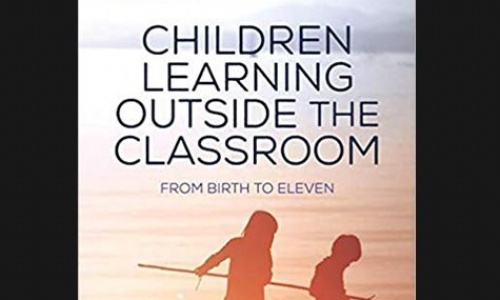CHILDREN LEARNING OUTSIDE THE CLASSROOM

Review by Sarah Hercod
‘Interdisciplinarity… a form of resistance against the bureaucratisation of education’ (Giroux, 2001)
How is this book organised?
This collection of essays, edited by Sue Waite, draws heavily on the experiences of academics, outdoor educators and teachers.
Chapters are written by different contributors, yet follow the same layout:
- Objectives
- Points for practice
- Case studies
- Thoughts about theory
- Summary
- Further reading and web links
Each chapter can be read in one sitting.
The authors assert that learning outside the classroom (LOtC) must be seen as integral to education. Each of the compulsory national curriculum subjects for primary education is discussed.
Tried and tested practical applications are offered for each area of discussion. For example, the benefits of physical Literacy, the importance of horizontal and vertical Mathematising (I love that word), utilising role-play and drama techniques to ignite imagination in History, and some really purposeful suggestions for the use of Technology outdoors. Some surprisingly easy strategies here, which have been swiftly assimilated into my KS2 class’ learning inside and outside the classroom.
I appreciated the ideas for establishing an inclusive outdoor environment for SEND and the contributor reminds practitioners that, for some children, LOtC is challenging and scary. Using small world resources to explore with children the risks and benefits is one helpful take-away from this insightful chapter.
What is learning outside the classroom?
LOtC is not always recognised as being synchronous with statutory expectations and the contributors don’t shy away from addressing this.
When LOtC is viewed through the lens as integral to children’s learning, it carries the same complexities as the indoor classroom.
Complexities:
What’s more valuable: learning to be a pupil or learning to be a learner?
Where do pupils learn best: through authentic activity and environments or through synthetic tasks and work-areas?
Is it possible for pupils to seamlessly transition between independent, co-constructed and teacher-led learning during a school day?
Can experiential and acquisitional learning achieve the same results?
Frankly, the same discordance exists between what will be measured by SATs and what we know, as professionals, that our learners ought to be able to demonstrate by the age of 11.
If the ideal approach is integrative then all learning opportunities - both inside and outside the classroom - must meet cognitive outcomes.
‘When planned and implemented well, learning outside the classroom contributed significantly to raising standards and improving pupils’ personal, social and emotional development. (Ofsted 2008:5)’
But how do we get there?
If LOtC is fully integrated into the school day, this book suggests that it will be inseparable from all the other types of learning on offer.
Key points:
- Be ready to embrace different sorts of teaching and learning approaches.
- Encourage less teacher-directed spaces beyond the classroom.
- Notice children’s competencies outdoors.
- Senior level support is essential.
- School staff need to be allowed time and resources to undertake the necessary work.
- Have a year-round approach to learning in an outdoor environment.
- Be flexible!
In the School Gardens chapter, one headteacher describes how his school has integrated the garden into every school day:
‘...like a plate of spaghetti. And all those bits tangle up together but they make a very good spaghetti.’
Summary:
Each chapter of this book transitions seamlessly from the theoretical to the practical and back again. There is plenty for the reflective practitioner to consider.
With a companion website, as well as a wealth of web links to support each chapter, this book is a resource that can be dipped in and out of, as well as shared with your team as the LOtC practice and ethos develops in your school.
What I will use in LOtC:
- Physical Literacy
- Horizontal Mathematising
- Drama techniques to ignite imagination in History
- Technology outdoors
- Small world role-play for risk/ benefit analysis with children
Book Title/Author: Children Learning Outside the Classroom, edited by Sue Waite.
